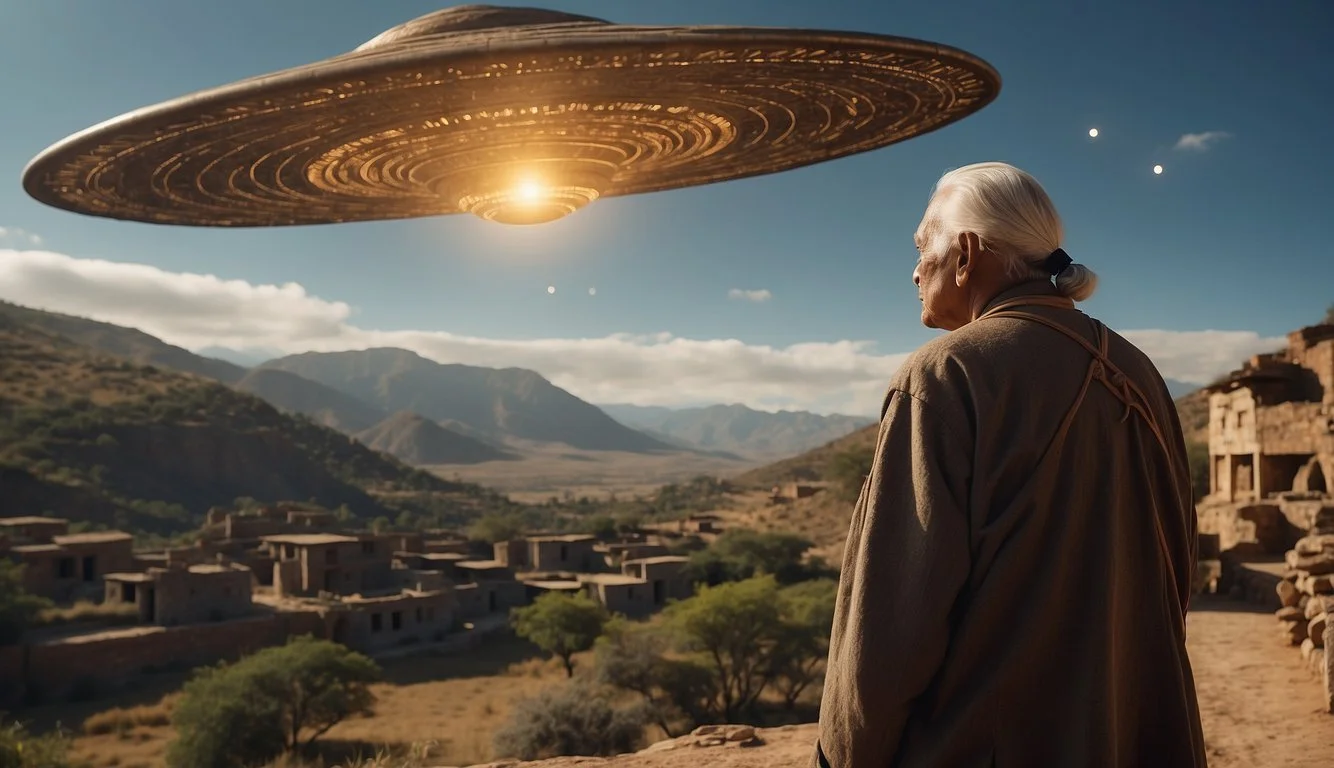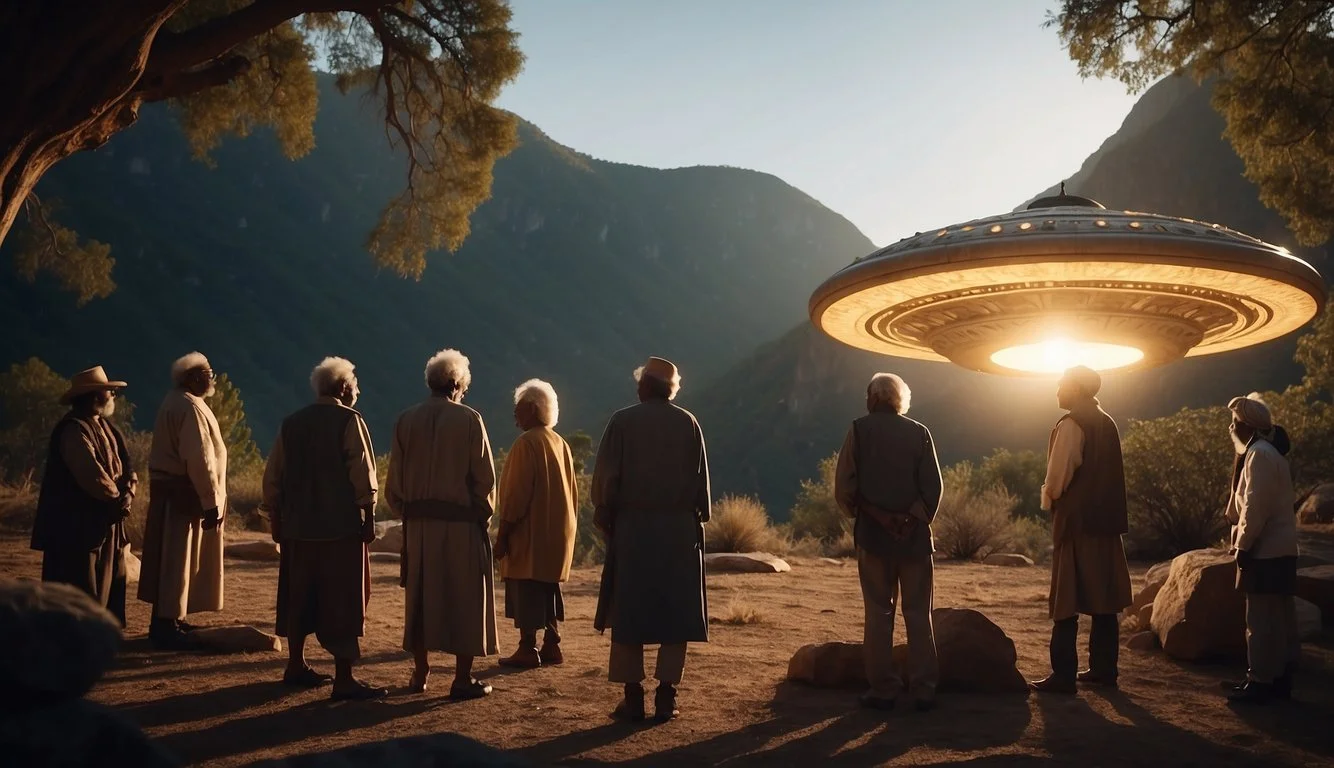The Unspoken UFO Legacy of American Indigenous Tribes: Cultural Encounters and Ancestral Narratives
American Indigenous tribes hold a rich tapestry of cultural narratives that have been passed down through generations, encompassing a wide range of spiritual beliefs, practices, and legendary figures. Among these narratives are tales that, according to some interpretations, may describe ancient encounters with otherworldly beings—often referred to as "Star People" or similar terms in various tribal languages. These stories are not merely folklore; for many tribes, they represent a significant part of their heritage and worldview, linking the people with the cosmos in a profound way.
One notable account from Lakota tradition, as mentioned by Wallace Black Elk in his book, tells of a UFO sighting and a subsequent telepathic communication with its extraterrestrial occupants. This story, alongside others from tribes like the Hopi, Cree, and Lakota, offers a glimpse into the complex and nuanced understanding Indigenous people have of extraterrestrial life and interstellar phenomena. The specific details of these encounters vary among tribes, but the overarching theme suggests a long-standing belief in connections between humans and otherworldly visitors.
These accounts, while often overshadowed by more mainstream UFO narratives, provide an essential perspective on the historical and ongoing relationship between Indigenous cultures and the subject of unidentified flying objects. The legacy of these experiences continues to be an integral, yet largely unspoken, element of Indigenous history, offering a unique lens through which to view the broader UFO phenomenon.
Historical Context
In addressing the legacy of indigenous tribes and their experiences, it is essential to recognize the historical systems and policies that have sought to reshape their identities. These include the establishment of Native American boarding schools, assimilation through legislation, and the role played by both the federal government and religious organizations.
Native American Boarding School Origins
Native American boarding schools emerged in the late 19th century with the intent to educate and assimilate First Nations children into Euro-American culture. The Indian Civilization Act of 1819 led to the creation of many such institutions, often far from children's families and communities. Operated by state-funded Christian schools, these boarding schools were meant to wipe out tribal identity and convert native children to Christianity.
Assimilation Policies and Legislation
Assimilation policies were structured by a series of laws aiming to integrate Native Americans into American society. Key legislation, like the Dawes Act of 1887, divided communal tribal lands into individual allotments and promoted the concept of private property. These laws were not mere land policies but were instruments designed to forcibly assimilate Native Americans into the settler society mold.
The Role of the Federal Government and Churches
The federal government and various religious organizations played pivotal roles in the establishment and operation of Native American boarding schools. Many of these institutions were run by religious groups who received federal support. They saw the education of native children as both a civilizing mission and a religious imperative. The government's goal, supported by legislation, was not merely education but the complete reshaping of indigenous identity.
Unearthing the Unspoken
This section delves into the revelations of unmarked graves within American Indigenous tribal lands and the subsequent reactions and actions from the public and government officials.
Discoveries of Unmarked Graves
Recent investigations have uncovered unmarked graves at several former sites of Native American boarding schools. The discoveries highlight a grim and unacknowledged chapter in the history of Indigenous tribes. Survey techniques and testimony have led to the identification of these burial sites.
Public Response and Interior Secretary's Role
Public outcry following the discovery of these graves has been significant, prompting government action. In response, Interior Secretary Deb Haaland, the first Native American to hold the office, has committed to addressing this tragic legacy. Haaland has been at the forefront of initiatives to protect burial sites and acknowledge the inhumane treatment that took place.
Documenting the Dark History
Efforts to document and acknowledge the history of Indigenous people's treatment have intensified. Interior Secretary Deb Haaland has initiated a comprehensive review of the federal boarding school system to understand the scope of the ongoing impact on Indigenous communities. The investigation encompasses cemeteries and seeks to offer protection to these sacred sites, ensuring respect and dignity for those who perished.
The Devastating Impact
The legacy of UFO encounters in American Indigenous tribes carries with it a burden of unspoken traumas and profound consequences that have deeply affected these communities.
Consequences for Indigenous Communities
The historical accounts of unidentified flying objects (UFOs) as part of American Indigenous folklore often intertwine with narratives of substantial trauma. For generations, these communities have reported incidents that go beyond mere sightings, carrying implications of physical and psychological abuse. The link between these events and a pattern of substance abuse within tribes is a complex interplay of coping mechanisms and deeply rooted long-standing trauma.
Loss of Human Life: Accounts suggest that interactions with what tribes identify as "Star People" could associate with unexplained fatalities, thereby contributing to the loss of human life within these communities.
Lasting Consequences: The perpetuation of cycles of violence and subsequent premature deaths have been tied back to the initial trauma of these encounters, leaving scars that are difficult to heal.
Personal Traumas and Loss
On an individual level, the repercussions of these encounters manifest as personal traumas and loss, echoing through time as mental disorders and intergenerational impact.
Mental Health: Cases of post-traumatic stress disorder (PTSD) and other mental disorders are frequently observed among individuals claiming close encounters or abductions, often with inadequate support systems for healing.
Intergenerational Trauma: Survivors pass down stories of unspoken traumas, and with them, a shadow of fear and distrust that shapes the community's psyche across generations. This shared pain is a burden that transcends individual experiences, contributing to a communal sense of long-standing trauma.
Efforts Towards Recognition and Healing
Recognition and healing initiatives have taken various forms, including government investigations and support for coalitions that provide awareness and pathways to the emotional healing of Indigenous peoples affected by historical events.
Governmental Actions and Investigations
The federal government has initiated actions to investigate historical wrongdoings against Indigenous tribes. These investigations aim to uncover and acknowledge the painful past, particularly regarding the implications of the UFO phenomena that are embedded in Indigenous lore and history. The TRUTH Project (Towards Recognition and University-Tribal Healing) exemplifies such efforts, seeking to bring to light the University of Minnesota's historical interactions with Native communities.
National Native American Boarding School Healing Coalition
The National Native American Boarding School Healing Coalition (NABS) is pivotal in raising awareness and addressing the intergenerational impact of boarding school policies on Native American communities. Their work advocates for accountability and constructs a platform for national conversation and emotional healing. They conduct research and offer resources to both document and mend the enduring effects of these past federal policies.
Intergenerational Impact and Emotional Healing
Indigenous communities are engaging in the process of emotional healing through a variety of means. From local support groups to large scale initiatives like Minnesota Transform, funded by the Andrew W. Mellon Foundation, efforts focus on decolonial and racial justice. Emotional healing is recognized as an essential part of the journey towards recognition, understanding the intergenerational trauma that persists, and fostering resilience within Indigenous cultures.
Protecting Cultural Heritage
American Indigenous tribes have long sought to protect their rich cultural heritage, something that has been both a challenge and a source of pride. This protection involves the retention and revitalization of native languages and traditions, and the affirmation of Indigenous identities against the backdrop of a historical struggle for autonomy.
Preservation of Languages and Traditions
For American Indigenous tribes, language is an integral component of cultural identity. Efforts to preserve linguistic diversity are crucial for the continuity of their heritage. For example, the Cree and Lakota communities have taken steps to ensure that their languages and traditions are passed down through generations. This can involve:
Educational programs: Schools and courses dedicated to teaching Indigenous languages.
Cultural events: Celebrations and gatherings that reinforce traditional practices.
Documentation: Efforts to record and archive languages for future study and use.
By fostering environments where traditional languages can thrive, these tribes not only protect their cultural heritage but also reinforce their sovereignty and tribal identities.
Safeguarding Indigenous Identities
Indigenous identities encompass a complex tapestry woven from tribal affiliations, cultural practices, and historical experiences. Native American tribes aim to safeguard these identities by:
Legal frameworks: Enacting tribal cultural property laws to protect and manage cultural resources.
Activism: Advocating for the recognition and respect of Native culture and history.
Cultural reclamation: Reviving traditional arts, crafts, and rituals to maintain a living culture.
Initiatives such as the creation of Mesa Verde National Park specifically to shield cultural heritage sites, and the enactment of cultural property laws by tribal entities, exemplify the steps taken to defend Indigenous identities and traditions. These actions affirm that Native American communities are not relics of the past but active, living cultures with a strong sense of unity and purpose.
Contemporary Challenges and Progress
The legacy of the UFO phenomena within American Indigenous tribes intersects with broader historical and contemporary struggles. These struggles include the ongoing impact of boarding schools on Indigenous societies and the push for policy reforms and advocacy efforts aimed at recognizing Indigenous rights and cultures.
Boarding School Impact on Today's Indigenous Societies
Boarding schools have left a deep mark on Indigenous families. Initiated as a tool for assimilation, these schools aimed to strip children of their cultural identity. Family structures were disrupted as children were taken to boarding schools, where many faced abuse and discrimination, and tragically, some died. The trauma inflicted by these institutions continues to affect Indigenous societies, as the loss of language and cultural practices impedes the transmission of traditional knowledge, including that related to the interpretation of the UFO legacy.
Policy Reforms and Ongoing Advocacy
Recent years have seen a concerted effort by Indigenous peoples and their allies to push for significant policy reforms. This has been partly in response to discrimination and the neglect of treaties made with various tribes. Advocacy groups and tribal leaders are working diligently to protect the rights of Indigenous peoples, secure recognition of tribal sovereignty, and ensure that historical oppressions are acknowledged and addressed. Particularly, they aim to enhance the wellbeing of those living on reservations in the Americas, ensuring their histories and voices regarding all matters—including UFO-related encounters and beliefs—are respected in contemporary discourse.
Confronting the Legacy
This section addresses the steps taken to address and educate about the unspoken UFO legacy among American Indigenous tribes, focusing on accountability and raising awareness.
The Path to Accountability
Agency staff from the United States Department of the Interior have taken significant steps toward addressing the historical consequences of policies that impacted Native American tribes. A vital element has been the investigation into the harmful legacy of forced boarding, an undertaking that not only separated Native American children from their families but also suppressed their cultural connections, including unique experiences such as those tied to "Star People" or UFO phenomena.
Accountability measures include:
Public disclosure of reports and findings.
Engagement with affected communities to understand the full impact.
Initiatives to preserve and protect Indigenous narratives regarding UFOs without compromising the privacy policy or individual account information.
The Importance of Education and Awareness
Education plays a crucial role in confronting and understanding the breadth of Indigenous experiences with unexplained aerial phenomena. Articles and documentaries bring forward stories like those of the Lakota tribe and Wallace Black Elk, shedding light on American Indian legends that have been historically overlooked.
Educational efforts encompass:
Developing curriculums that include Indigenous history and perspectives.
Organizing seminars and trainings for both the public and officials to disseminate accurate information.
Encouraging cabinet secretaries and staff to initiate programs that wipe out ignorance and replace it with knowledge and respect for Indigenous legacies connected to UFO experiences.
Conclusion
The intricate web of narratives surrounding unidentified flying objects (UFOs) within American Indigenous folklore is a tapestry steeped in mystery. In addressing tribal affiliations, the Lakota are among those tribes that resonate with tales of 'Star People', potentially indicative of extraterrestrial contact. Through oral histories, figures like Wallace Black Elk have shared encounters, infusing an additional layer of the extraordinary into the rich cultural tapestry.
These accounts are more than just stories; they represent a facet of heritage calling for oversight and compiling by entities tasked with preserving Indigenous narratives. This endeavor mirrors the unprecedented work led by the U.S. Interior Secretary, who initiated a reviewing of the painful history of past boarding schools, aiming for emotional healing and accountability through a final report.
The engagement in such historical reassessments suggests a gradual, yet significant, shift towards taking responsibility for past transgressions. This societal progression could logically extend towards a formal apology to Indigenous communities, acknowledging the profound impact of anecdotal extraterrestrial encounters, and the marginalization of these stories in mainstream discourse.
In conclusion, a comprehensive assessment of the Indigenous UFO legacy demands an amalgamation of scientific curiosity and a respectful acknowledgment of the wisdom of the grandmother—a metaphor for the Native tradition and its stories. The careful weaving of these narratives into the broader historical context is pivotal, not only for emotional healing but also as a testament to the rich and complex history of Native American tribes.






